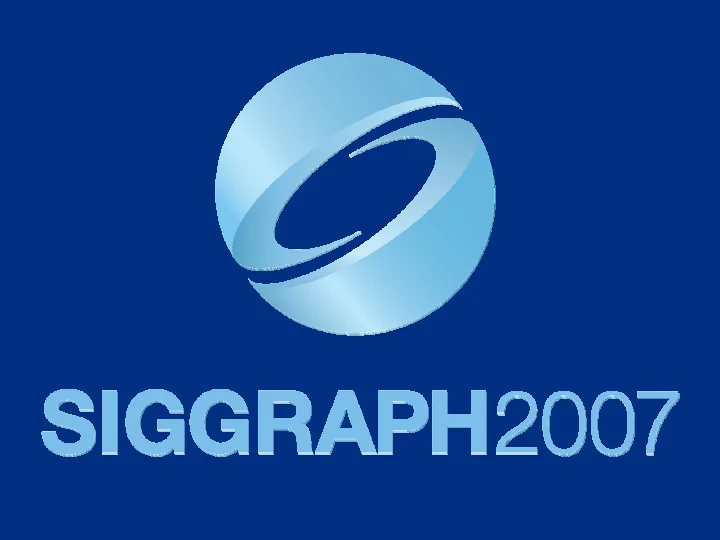

A Gentle Introduction A Gentle Introduction to Bilateral Filtering to Bilateral Filtering and its Applications and its Applications Limitation? Pierre Kornprobst (INRIA) 0:20
Bilateral filter Soft texture is removed Input Examples Examples
Examples Examples Constant regions appear Bilateral filter Input [Buades, Coll, Morel, 2005]
input Staircase effect Staircase effect • Bilateral filter tends to remove texture, create flat intensity regions and new contours • Questions – Why does it occur? – Can this be an advantage? – Otherwise, can we solve this problem? output
• Bilateral filter is a weighted average of space intensities and… range Why? Why?
Why? Why? range space • The number of points q satisfying I p -h<I q <I p is larger than the number satisfying I p <I q <I p +h .
Why? Why? range space • Thus the average value is smaller than I p , enhancing that part of the signal. Note: Of course, opposite reasoning the the concave case
And Gaussians don’t change anything And Gaussians don’t change anything space range
And Gaussians don’t change anything And Gaussians don’t change anything space range
And Gaussians don’t change anything And Gaussians don’t change anything space range
[Winnemöller, Olsen, Gooch, 2006] So… Can this be an advantage? So… Can this be an advantage? • Yes! Since we obtain cartoon-like pictures, let us do cartoons!... Input Output
[Winnemöller, Olsen, Gooch, 2006] I said cartoons? I said cartoons?
Few words about the approach Few words about the approach [Winnemoller, Olsen, Gooch, 2006]
[Winnemöller, Olsen, Gooch, 2006] And you can do more! And you can do more! • Real-time video abstraction • To know more http://www.cs.northwestern.edu/~holger/Research/VideoAbstraction/ You want to see some example?
But… But… • We don’t always want to have this kind of rendering • When bilateral filter is used some side effects car appear
HDR input
Tone mapping with look transfer [Bae, Paris and Durand, 2006] Not acceptable for a photographer! Result without correcting the BF output
Can we avoid this defect? Can we avoid this defect?
“Gradient manipulation” “Gradient manipulation” Goal of the paper was to control [Bae, Paris and Durand, 2006] photographic look and transfer a “look” from a model photo 1. In the gradient domain : – Compare gradient amplitudes of input and current – Prevent increase 2. Solve the Poisson equation See [Perez etal, 2003] on Poisson image editing See [Agarwala, 2007] on solving Poisson equation for large images
Tone mapping with look transfer [Bae, Paris and Durand, 2006] Result without correcting the BF output
Tone mapping with look transfer [Bae, Paris and Durand, 2006] Note that problems are essentially visible near strong contours Result with corrected BF output
Edge Blending Edge Blending Goal of the paper was the display of [Durand and Dorsey, 2002] high-dynamic-range images • With a single iteration, staircase effects is visible only at edges. • Edges detected with normalization factor (see also [Smith and Brady, 1997]) • Blend edges with smoothed version of input to counteract staircase effect (Combination between BF and Gaussian results at strong contours locations)
Result without correction Result with correction Result without correction Result with correction Tone Mapping Tone Mapping [Durand 02] [Durand 02]
“Linear interpolation” “Linear interpolation” Goal of the paper was to establish the [Buades, Coll, Morel, 2005] link between integral formulations and differential operators • We saw that bilateral filter behaves like Perona-Malik and thus creates flat zones • They proposed to replace the simple average by a linear regression • How?
“Linear interpolation” “Linear interpolation” • Bilateral filter can be expressed by • If you derive, you obtain
“Linear interpolation” “Linear interpolation” • Bilateral filter can be expressed by • [Buades, Coll, Morel, 2005] changed the constant model by an affine model • New value at p will be
“Linear interpolation” “Linear interpolation” Geometrical interpretation range space • Remember, the problem was that lower values were more taken into consideration
“Linear interpolation” “Linear interpolation” Geometrical interpretation range space • Now, left and right-hand side parts have the same influence
Bilateral filter Staircase effect Staircase effect Input
With linear interpolation… With linear interpolation… Bilateral filter modified Input [Buades, Coll, Morel, 2005]
Also… Also… • This new operator is also related to differential operators, i.e., PDEs! • In this paper, you will also find extensions of bilateral filter, called non local filter. Average when Average when similar intensities similar patch around (correlation of neighborhood) [Buades, Coll, Morel, 2005]
How to choose? How to choose? • Two methods which correct afterward defects of bilateral filter, mainly visible on boundaries. Efficient Correction of an existing problem • One method which solves the problem by adapting the bilateral filter. Directly address the problem Computationally expensive
Summary Summary • Bilateral filter produces staircase effect • It has been used as a tool for many applications such as texture extraction • By itself, it has some interest too! • Staircase effect can be controlled • The link with PDEs is again appearing
Questions? Questions? Pierre.kornprobst@inria.fr http://pierre.kornprobst.googlepages.com/
Recommend
More recommend